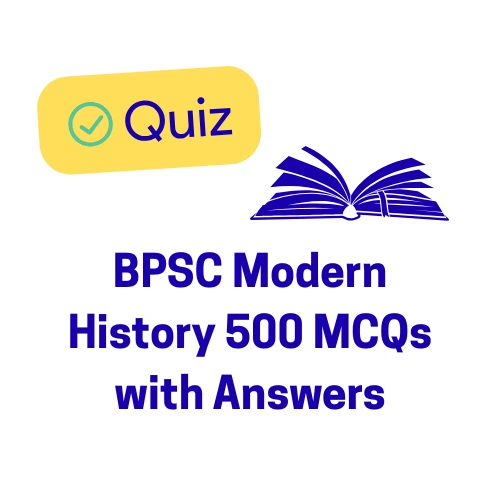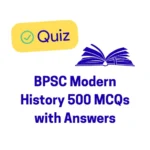BPSC Modern History Part 1 (500 MCQs) – (Advent of Europeans & British in Bengal)
BPSC Modern History Part 1
Section A: Advent of Europeans
Q1. Which European power was the first to establish a factory at Masulipatnam in India?
(A) Portuguese
(B) British
(C) Dutch
(D) French
Q2. The ‘Blue Water Policy’ was introduced by which Portuguese Governor in India?
(A) Vasco da Gama
(B) Afonso de Albuquerque
(C) Nuno da Cunha
(D) Francisco de Almeida
Q3. Which of the following is/are correctly matched regarding the first entry points of European powers in India?
(A) British: Masulipatnam
(B) Dutch: Surat
(C) Danish: Pondicherry
(D) French: Tranquebar
(E) None of the above / More than one of the above
Q4. Who among the following is widely known as the “real founder of Portuguese power in India”?
(A) Francisco de Almeida
(B) Vasco da Gama
(C) Nuno da Cunha
(D) Afonso de Albuquerque
Q5. The Cartaze System, a naval pass system introduced by the Portuguese to control and tax Indian ships, was established during the tenure of which Governor/Viceroy?
(A) Francisco de Almeida
(B) Vasco da Gama
(C) Afonso de Albuquerque
(D) Pedro Álvares Cabral
BPSC Modern History Part 1
Q6. Which of the following European powers introduced the printing press to India in 1556 in Goa?
(A) Dutch
(B) British
(C) French
(D) Portuguese
Q7. Which Mughal Emperor granted Captain William Hawkins the title of ‘English Khan’?
(A) Akbar
(B) Shah Jahan
(C) Jahangir
(D) Aurangzeb
Q8. Which important center did the Portuguese cede to Charles II of England as dowry in 1662?
(A) Goa
(B) Diu
(C) Cochin
(D) Bombay
Q9. Which of the following crops was/were introduced to India by the Portuguese from Central America?
Potato
Maize
Tobacco
Coffee
(A) 1 and 2 only
(B) 1, 2, and 3 only
(C) 4 only
(D) 1, 2, 3, and 4
Q10. The English East India Company’s Golden Farman in 1632 was issued by the Sultan of which kingdom?
(A) Bijapur
(B) Golconda
(C) Ahmednagar
(D) Malacca
Q11. The Dutch were decisively defeated by the English in the Battle of Bedara (Baidara) in Bengal in which year?
(A) 1612
(B) 1757
(C) 1759
(D) 1764
Q12. Which set of Farmans, issued by a Mughal Emperor, is known as the “Magna Carta” of the East India Company?
(A) The Farman of Jahangir (1613)
(B) The Golden Farman of Golconda (1632)
(C) The Farman of Farrukhsiyar (1717)
(D) The Farman of Shah Alam II (1765)
Q13. Who was the Gujarati pilot that helped Vasco da Gama reach Calicut in 1498?
(A) Amerigo Vespucci
(B) Abdul Majid
(C) Bartholomeu Dias
(D) Pedro Álvares Cabral
Q14. The Danes established their first factory at Tranquebar in Tamil Nadu in which year?
(A) 1602
(B) 1608
(C) 1616
(D) 1620
Q15. The English shifted their company headquarters from Surat to which city in 1687?
(A) Bombay
(B) Madras (Fort St. George)
(C) Calcutta (Fort William)
(D) Masulipatnam
Section B: British in Bengal and Early Conquests
Q16. Who was the founder of the independent regional state of Bengal?
(A) Shuja-ud-Daula
(B) Siraj-ud-Daula
(C) Alivardi Khan
(D) Murshid Quli Khan
Q18. In which battle did Alivardi Khan defeat and kill Sarfaraz Khan to become the Nawab of Bengal?
Introduction of Taccavi loans to cultivators
Conversion of Jagir lands into Khalsa lands.
Introduction of the Ijaradari (Jaredari) system for land revenue collection.
(A) 1 and 2 only
(B) 2 and 3 only
(C) 1 and 3 only
(D) 1, 2, and 3
Q18. In which battle did Alivardi Khan defeat and kill Sarfaraz Khan to become the Nawab of Bengal?
(A) Battle of Buxar
(B) Battle of Plassey
(C) Battle of Giria
(D) Battle of Manihari
Q19. The Nawab of Bengal who compared the British to a ‘beehive,’ stating that if they did not tease, they gave honey, was:
(A) Murshid Quli Khan
(B) Siraj-ud-Daula
(C) Mir Qasim
(D) Alivardi Khan
Q20. Siraj-ud-Daula secured his succession by defeating his rival Shaukat Jung (Faujdar of Purnia) in which battle?
(A) Battle of Giria
(B) Battle of Plassey
(C) Battle of Manihari
(D) Battle of Buxar
Q21. The immediate cause for the Battle of Plassey (1757) was:
(A) Siraj-ud-Daula’s demand for the Diwani rights of Bengal.
(B) The British refusal to obey Siraj-ud-Daula’s order to stop fortification of factories.
(C) Mir Jafar’s secret alliance with the French against the Nawab.
(D) The attack on Qasim Bazar by Robert Clive.
BPSC Modern History Part 1
Q22. Who among the following betrayed Siraj-ud-Daula in the Battle of Plassey?
Mir Jafar
Jagat Seth
Mir Madan
(A) 1, 2, and 3 only
(B) 1, 2 only
(C) 1, 3 only
(D) 1 only
Q23. Who was the Nawab of Bengal who shifted his capital from Murshidabad to Munger (Bihar) to maintain distance from British control?
(A) Murshid Quli Khan
(B) Siraj-ud-Daula
(C) Mir Jafar
(D) Mir Qasim
Q24. Which of the following steps was/were taken by Mir Qasim to consolidate his power and authority?
Abolished internal duties on all traders.
Modernized the army on European lines.
Appointed loyal officials to the administration.
(A) 1 and 2 only
(B) 2 and 3 only
(C) 1 and 3 only
(D) 1, 2, and 3
Q25. Who was the Nawab of Awadh who joined the Tripartite Alliance against the British in the Battle of Buxar (1764)?
(A) Safdar Jang
(B) Shuja-ud-Daula
(C) Asaf-ud-Daula
(D) Bahadur Shah
BPSC Modern History Part 1
Q26. Which of the following individuals was NOT a part of the Tripartite Alliance defeated in the Battle of Buxar?
(A) Mir Qasim
(B) Shuja-ud-Daula
(C) Mughal Emperor Shah Alam II
(D) Mir Jafar
(E) None of the above / More than one of the above
Q27. The Battle of Buxar (1764) was fought under the command of which British officer?
(A) Robert Clive
(B) Captain Thomas Best
(C) Sir Eyre Coote
(D) Hector Munro
Q28. Under the Treaty of Allahabad (1765), the Mughal Emperor Shah Alam II granted the Diwani rights (revenue collection) of which regions to the East India Company?
(A) Bengal, Bihar, and Orissa
(B) Bengal and Awadh
(C) Bengal, Bihar, and Awadh
(D) Bengal and Orissa only
Q29. The Nawab of Awadh, Shuja-ud-Daula, was made to pay how much as war indemnity to the Company under the Treaty of Allahabad?
(A) ₹26 lakh
(B) ₹53 lakh
(C) ₹50 lakh
(D) ₹12 lakh
Q30. The Dual Government System in Bengal, introduced by Robert Clive, kept the Nizamat functions (Police & Judicial Affairs) nominally under the control of which authority?
(A) The East India Company
(B) The Mughal Emperor
(C) The Nawab of Bengal
(D) The Naib-Subahdar appointed by the British


